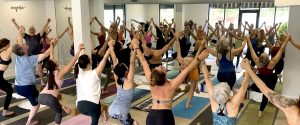Yoga Practice Improves Mood and Spirituality Regardless of Physical or Spiritual Instruction
By John M. de Castro, Ph.D.
“The word yoga means to join or unite, and yogis view this unison in different ways – the unison of body, mind and spirit, uniting all the aspects of yourself, or uniting with a higher power or spiritual force.” – DoYou
Yoga developed in India millennia ago as a deep spiritual practice. It developed as a contemplative practice that unified body and mind. Yoga was known to have physical benefits, but the most important benefit was seen to be spiritual development. But as yoga emerged and was practiced in the west it was secularized. This was for good reason, as western society was not ready to accept an ancient eastern spiritual practice.
There are many forms of yoga and many practitioners who are focused on the spiritual aspects of yoga. But, to the vast majority of westerner’s yoga is an exercise for physical fitness. It is a means to mold the body to look good, as a health promoting practice, and as a strategy to help lose weight. These are good and reasonable goals. But they have replaced the spiritual development originally promoted by yoga. As Jon Kabat-Zinn has remarked, ‘there is the potential for something priceless to be lost.’
It may be speculated that the instructions provided with yoga training may produce different effects on the physical and spiritual benefits. In today’s Research News article “Verbal Cuing Is Not the Path to Enlightenment. Psychological Effects of a 10-Session Hatha Yoga Practice.” (See summary below or view the full text of the study at: https://www.frontiersin.org/articles/10.3389/fpsyg.2020.01375/full?utm_source=F-AAE&utm_medium=EMLF&utm_campaign=MRK_1373328_69_Psycho_20200709_arts_A) Csala and colleagues recruited female college students with no previous experience with yoga and randomly assigned them to receive 10 weekly 1.5 hour training sessions in Hatha yoga designated either as “Sport” yoga or “Spiritual” yoga or to a no treatment control condition. The “Sport” yoga and “Spiritual” yoga only differed in instructions. The “Sport” yoga group was instructed with an emphasis on the physical aspects of yoga (e.g., correct position, muscles involved). The “Spiritual” yoga group was instructed with an emphasis on the spiritual aspects of yoga (e.g. energetic body and blockages, chakras, meditations etc.). They were measured before and after training for body awareness, mindfulness, positive and negative emotions, and spiritual connections.
They found that in comparison to baseline and the no-treatment control condition the practice of either “Sport” or “Spiritual” yoga produced significant increases in spiritual connections and significant decreases in negative emotions. Hence, regardless of whether the instructions emphasized the physical or spiritual aspects of yoga practice, the same effects occurred of increased spirituality and mood.
Yoga practice has been repeatedly shown in prior research studies to improve mood. So, the observed mood enhancement effects were no surprise. But, the ability of yoga practice to increase spirituality even when the spiritual aspects of yoga were not talked about is surprising. Regardless of instruction Hatha yoga practice produced increased spirituality. This suggests that the western emphasis on the secular aspects of yoga may not interfere with the enhancement of spirituality produced by yoga practice.
Perhaps yoga practice makes the individual more aware of the physical limitations of the body and that by itself may put human existence into perspective, amplifying the importance of the non-physical, spiritual, aspects. Yoga practice has for centuries been practiced in the east enhancing spirituality. It is interesting to find that it has the same effects in the west even when there is no instruction on the spiritual side of yoga practice.
So, yoga practice improves mood and spirituality regardless of physical or spiritual instruction.
“yoga offers much more than just a way to exercise the body. The deeper meaning and gift of yoga is the path it offers into the timeless world of spirit.” – Chopra.com
CMCS – Center for Mindfulness and Contemplative Studies
This and other Contemplative Studies posts are also available on Google+ https://plus.google.com/106784388191201299496/posts and on Twitter @MindfulResearch
Study Summary
Csala B, Ferentzi E, Tihanyi BT, Drew R and Köteles F (2020) Verbal Cuing Is Not the Path to Enlightenment. Psychological Effects of a 10-Session Hatha Yoga Practice. Front. Psychol. 11:1375. doi: 10.3389/fpsyg.2020.01375
Verbal instructions provided during yoga classes can differ substantially. Yoga instructors might choose to focus on the physical aspects of yoga (e.g., by emphasizing the characteristics of the poses), or they might take a more spiritual approach (e.g., by mentioning energy flow and chakras). The present study investigated the effects of verbal cues during yoga practice on various psychological measures. Eighty-four female students (22.0 ± 3.80 years) participated in the study. Two groups attended a beginner level hatha yoga course in which physically identical exercise was accompanied by different verbal cues. The so-called “Sport group” (N = 27) received instructions referring primarily to the physical aspects of yoga practice, while the “Spiritual group” (N = 23) was additionally provided with philosophical and spiritual information. A control group (N = 34) did not receive any intervention. Mindfulness, body awareness, spirituality, and affect were assessed 1 week before and after the training. 2 × 3 mixed (time × intervention) ANOVAs did not show an interaction effect for any of the variables. However, when the two yoga groups were merged and compared to the control group, we found that spirituality increased, and negative affect decreased among yoga participants. In conclusion, yoga practice might influence psychological functioning through its physical components, independent of the style of verbal instructions provided.
